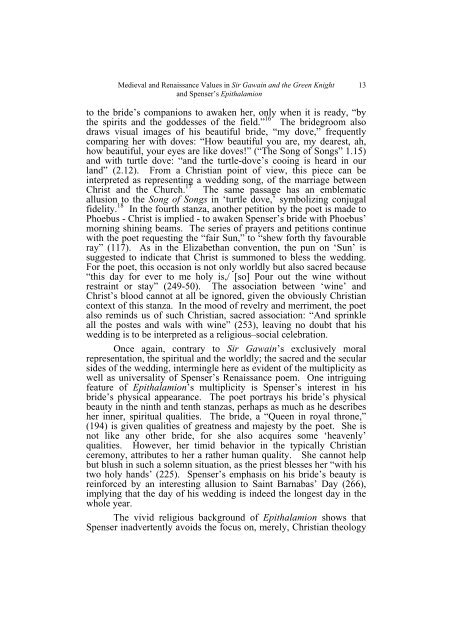Journal of Taibah University the first issue
Journal of Taibah University the first issue
Journal of Taibah University the first issue
Create successful ePaper yourself
Turn your PDF publications into a flip-book with our unique Google optimized e-Paper software.
Medieval and Renaissance Values in Sir Gawain and <strong>the</strong> Green Knight<br />
and Spenser’s Epithalamion<br />
13<br />
to <strong>the</strong> bride’s companions to awaken her, only when it is ready, “by<br />
<strong>the</strong> spirits and <strong>the</strong> goddesses <strong>of</strong> <strong>the</strong> field.” 16 The bridegroom also<br />
draws visual images <strong>of</strong> his beautiful bride, “my dove,” frequently<br />
comparing her with doves: “How beautiful you are, my dearest, ah,<br />
how beautiful, your eyes are like doves!” (“The Song <strong>of</strong> Songs” 1.15)<br />
and with turtle dove: “and <strong>the</strong> turtle-dove’s cooing is heard in our<br />
land” (2.12). From a Christian point <strong>of</strong> view, this piece can be<br />
interpreted as representing a wedding song, <strong>of</strong> <strong>the</strong> marriage between<br />
Christ and <strong>the</strong> Church. 17 The same passage has an emblematic<br />
allusion to <strong>the</strong> Song <strong>of</strong> Songs in ‘turtle dove,’ symbolizing conjugal<br />
fidelity. 18 In <strong>the</strong> fourth stanza, ano<strong>the</strong>r petition by <strong>the</strong> poet is made to<br />
Phoebus - Christ is implied - to awaken Spenser’s bride with Phoebus’<br />
morning shining beams. The series <strong>of</strong> prayers and petitions continue<br />
with <strong>the</strong> poet requesting <strong>the</strong> “fair Sun,” to “shew forth thy favourable<br />
ray” (117). As in <strong>the</strong> Elizabethan convention, <strong>the</strong> pun on ‘Sun’ is<br />
suggested to indicate that Christ is summoned to bless <strong>the</strong> wedding.<br />
For <strong>the</strong> poet, this occasion is not only worldly but also sacred because<br />
“this day for ever to me holy is,/ [so] Pour out <strong>the</strong> wine without<br />
restraint or stay” (249-50). The association between ‘wine’ and<br />
Christ’s blood cannot at all be ignored, given <strong>the</strong> obviously Christian<br />
context <strong>of</strong> this stanza. In <strong>the</strong> mood <strong>of</strong> revelry and merriment, <strong>the</strong> poet<br />
also reminds us <strong>of</strong> such Christian, sacred association: “And sprinkle<br />
all <strong>the</strong> postes and wals with wine” (253), leaving no doubt that his<br />
wedding is to be interpreted as a religious–social celebration.<br />
Once again, contrary to Sir Gawain’s exclusively moral<br />
representation, <strong>the</strong> spiritual and <strong>the</strong> worldly; <strong>the</strong> sacred and <strong>the</strong> secular<br />
sides <strong>of</strong> <strong>the</strong> wedding, intermingle here as evident <strong>of</strong> <strong>the</strong> multiplicity as<br />
well as universality <strong>of</strong> Spenser’s Renaissance poem. One intriguing<br />
feature <strong>of</strong> Epithalamion’s multiplicity is Spenser’s interest in his<br />
bride’s physical appearance. The poet portrays his bride’s physical<br />
beauty in <strong>the</strong> ninth and tenth stanzas, perhaps as much as he describes<br />
her inner, spiritual qualities. The bride, a “Queen in royal throne,”<br />
(194) is given qualities <strong>of</strong> greatness and majesty by <strong>the</strong> poet. She is<br />
not like any o<strong>the</strong>r bride, for she also acquires some ‘heavenly’<br />
qualities. However, her timid behavior in <strong>the</strong> typically Christian<br />
ceremony, attributes to her a ra<strong>the</strong>r human quality. She cannot help<br />
but blush in such a solemn situation, as <strong>the</strong> priest blesses her “with his<br />
two holy hands’ (225). Spenser’s emphasis on his bride’s beauty is<br />
reinforced by an interesting allusion to Saint Barnabas’ Day (266),<br />
implying that <strong>the</strong> day <strong>of</strong> his wedding is indeed <strong>the</strong> longest day in <strong>the</strong><br />
whole year.<br />
The vivid religious background <strong>of</strong> Epithalamion shows that<br />
Spenser inadvertently avoids <strong>the</strong> focus on, merely, Christian <strong>the</strong>ology


